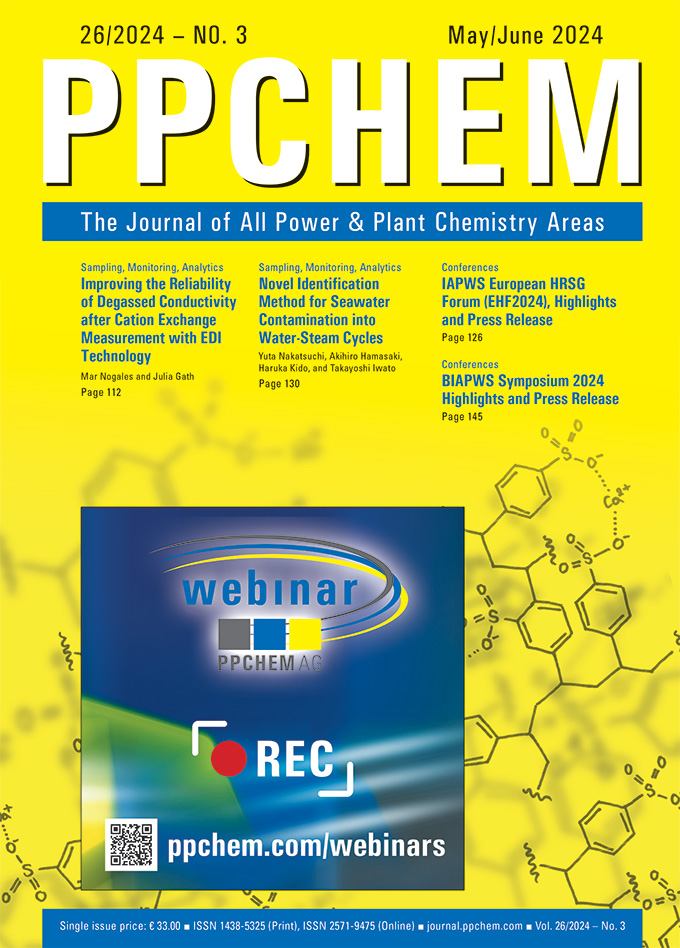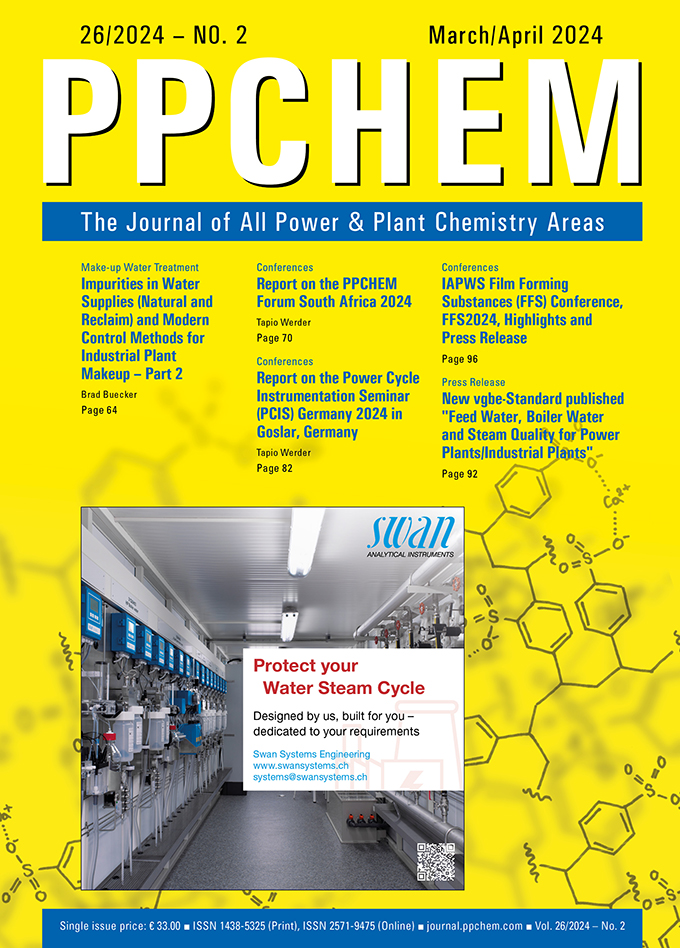Author: anderthalbAdmin
Article – Issue 03 (2024) – BIAPWS Symposium 2024 Highlights and Press Release
Download the Article’s PDF.
Article – Issue 03 (2024) – Novel Identification Method for Seawater Contamination into Water-Steam Cycles
Issue 03 (2024)

For members only
ABSTRACTS
Improving the Reliability of Degassed Conductivity after Cation Exchange Measurement with EDI Technology
Mar Nogales and Julia Gath
During the startup of a water-steam cycle, CO2 is the primary contributor to increased conductivity after cation exchange (CACE) values. It is generally accepted that CO2 is the least aggressive contaminant in a water-steam cycle. Therefore, it is essential to reliably demonstrate that the increased CACE is due to CO2 and not to more harmful contaminants like chloride or organic acids. Elimination of the carbon dioxide contribution is possible via thermal degassing of the sample, and subsequent measuring of the degassed CACE (DCACE). The reproducibility of the degassing process is an essential prerequisite for reliable measurements.
A CACE measurement system utilizing an electrodeionization device (EDI) for the cation exchange was introduced to the market in 2016 and has proven to be dependable. This paper describes how this established technology has been enhanced with a reliable degassing unit, resulting in a DCACE measurement utilizing an EDI device for the cation exchange.
PPCHEM® 2024, 26(3), 112–117
For Members only
IAPWS European HRSG Forum (EHF2024)
Highlights and Press Release
The tenth annual IAPWS European HRSG Forum was held on the 13th–15th May 2024 in Prato, Italy. It was chaired by Barry Dooley of Structural Integrity and Bob Anderson of Competitive Power Resources. EHF2024 attracted 90 participants from 18 countries and included 40 users. The EHF2024 event was organized by Mecca Concepts, Australia. The 2024 EHF had 13 sponsors: Dekomte, NEM, John Cockerill, Tuff Tube Transition, Precision Iceblast Corporation, Altrad Babcock, TesTex, Arnold Group, Valve Pro/Conval, Advanced Valve Solutions, Cormetech, Groome Industrial Services and Metroscope.
PPCHEM® 2024, 26(3), 126–128
For Members only
Novel Identification Method for Seawater Contamination into Water-Steam Cycles
Yuta Nakatsuchi, Akihiro Hamasaki, Haruka Kido, and Takayoshi Iwa
In the water-steam cycle of power plants, cation conductivity is measured to promptly detect contamination by impurities such as seawater and prevent corrosion damage to equipment and piping. Cation conductivity is obtained by measuring the electrical conductivity of the sample after the cation exchange pretreatment, making the highly sensitive detection of anion impurities possible. However, due to a policy of increased introduction of renewable energy, frequent start and stop operation of combined cycle power plants is increasing. As a result, interference with cation conductivity measurements by carbon dioxide which enters from the air during plant outages will increase, making the delayed detection of contamination by impurities a matter of concern. Therefore, a novel identification method for impurities based on the pH, specific conductivity, and cation conductivity, which are monitored conventionally in the water-steam cycle, has been investigated.
As a result of the calculation of impurity concentrations using the novel model of the simulated water quality of a water-steam cycle prepared by chemical equilibrium calculation software, it has been confirmed that the calculation error for carbon dioxide concentrations not from seawater is 0.0 % to 18 % more than 0.1 mg ⋅ L–1, and that for seawater contamination is 0.0 % to 20 % more than 1 ⋅ 10–6 m3 ⋅ m–3, which is regarded as good agreement. Additionally, the calculated results with measured data from two power plants are consistent with the assumed behavior based on the plant status. In conclusion, it is indicated that the amount of seawater can be precisely estimated even in the case of the presence of both carbon dioxide and seawater by using this novel method.
PPCHEM® 2024, 26(3), 130–143
For Members only
BIAPWS Symposium 2024
Highlights and Press Release
The British and Irish Association for the Properties of Water and Steam (BIAWPS) hosted their 23rd Annual Power Plant Chemistry Symposium on 22nd–23rd May at Warwick University, Coventry, UK. The Symposium was attended by around 90 members of the UK and Ireland water/steam cycle chemistry community, with a good mix of Operators, Vendors, and Suppliers to the water treatment industry.
PPCHEM® 2024, 26(3), 145
Article – Issue 03 (2024) – IAPWS European HRSG Forum (EHF2024), Highlights and Press Release
Download the Article’s PDF.
Article – Issue 03 (2024) – Improving the Reliability of Degassed Conductivity after Cation Exchange Measurement with EDI Technology
E-Paper – Issue 02 (2024)
Issue 02 (2024)

For members only
ABSTRACTS
Impurities in Water Supplies (Natural and Reclaim) and Modern Control Methods for Industrial Plant Makeup – Part 2
Brad Buecker
Reducing industrial water consumption is a key aspect to conserving available fresh water sources. In the United States, as well as in other regions globally, project developers and design engineers for numerous power and industrial plants are opting for alternatives to fresh water for plant makeup. Effluent from municipal wastewater treatment plants, also known as “reclaim” or “grey” water, is becoming more popular as an alternative water source. The article discusses the problematic impurities found in effluent and suggests modern approaches to address these contaminants. It emphasizes the importance of careful evaluation and planning when designing industrial makeup water treatment systems, regardless of whether the water supply is fresh or an alternative source. Additional treatment might be needed to safeguard industrial plant water systems against microbiological fouling, scale formation, and corrosion.
PPCHEM® 2024, 26(2), 64–68
For Members only
Report on the PPCHEM Forum South Africa 2024
Tapio Werder
For the third time in the history of these events, the PPCHEM Forum (PPCF) series stopped over in South Africa. The PPCF South Africa 2024 in Pretoria was held under the patronage of PPCHEM AG, with financial sponsorship from SWAN Analytical Instruments, Switzerland, and Sentry Equipment Corp., USA.
The PPCF series offers valuable insights into power plant chemistry objectives and tasks, covering essential topics such as water chemistry, proper sampling techniques, corrosion science, and more. It’s designed to be understandable not just to chemical experts but also to those without a chemistry background. The various operating regimes, the relevant industry guidelines and standards, and the correct and optimum selection and application in relation to the individual plant design are discussed, as well as the necessary considerations for the operational monitoring concept.
This report summarizes the two days of the PPCHEM Forum South Africa 2024.
PPCHEM® 2024, 26(2), 70–74
For Members only
Report on the Power Cycle Instrumentation Seminar (PCIS) Germany 2024 in Goslar, Germany
Tapio Werder
For the first time in the history of these events, the Power Cycle Instrumentation Seminar (PCIS) series stopped over in Germany. The PCIS Germany 2024 in Goslar was held under the patronage of PPCHEM AG, with financial sponsorship from SWAN Analytical Instruments and REICON Wärmetechnik und Wasserchemie Leipzig GmbH.
The PCIS series provides a well-proven mixture of theoretical background information on cycle chemistry, sampling, and monitoring as well as a deeper look into analytical methods and critical issues for each parameter, concerning operation, verification, and calibration.
This report summarizes the two days of the PCIS Germany 2024.
PPCHEM® 2024, 26(2), 82–85
For Members only
New vgbe-Standard published “Feed Water, Boiler Water and Steam Quality for Power Plants/Industrial Plants”
vgbe energy e.V. hereby presents a revised version of the VGB-Standard VGB-S-010 for “Feed Water, Boiler Water and Steam Quality for Power Plants/Industrial Plants”. This revised vgbe-Standard replaces the former edition 2011.
PPCHEM® 2024, 26(2), 92
IAPWS Film Forming Substances (FFS) Conference, FFS2024 Highlights and Press Release
The seventh IAPWS FFS International Conference was held on the 26th – 28th March 2024 in Prato, Italy chaired by Barry Dooley of Structural Integrity Associates, UK and David Addison of Thermal Chemistry, New Zealand. The FFS conferences are unique on a narrow topic in cycle chemistry control of power plants and steam generating facilities. In 2024 the conference attracted 50 participants from 16 countries from all over the world which included 10 plant operators / users and representatives from 12 FFS chemical suppliers.
PPCHEM® 2024, 26(2), 96–98
Article – Issue 02 (2024) – IAPWS Film Forming Substances (FFS) Conference, FFS2024, Highlights and Press Release
Download the Article’s PDF.
Article – Issue 02 (2024) – New vgbe-Standard published “Feed Water, Boiler Waterand Steam Quality for Power Plants/Industrial Plants”
Download the Article’s PDF.


